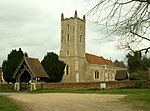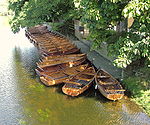Stratford St. Mary

Stratford St. Mary is a village in Suffolk, England in the heart of 'Constable Country'. John Constable painted a number of paintings in and around Stratford. Stratford (the ford of the Roman Via Strata) with its attached hamlet of Higham sits on the Suffolk/Essex border on the River Stour, Suffolk. It is 58 miles (93 km) from London just off the A12 between Colchester and Ipswich. The village has a fifteenth-century flint faced church which is clearly visible from the A12. It is also served by a primary school, post office and village store, and three pubs. Stratford village is within the Stratford Vale which is also recognised as an area of outstanding natural beauty.
Excerpt from the Wikipedia article Stratford St. Mary (License: CC BY-SA 3.0, Authors, Images).Stratford St. Mary
Essex Way, Colchester Langham
Geographical coordinates (GPS) Address Nearby Places Show on map
Geographical coordinates (GPS)
| Latitude | Longitude |
|---|---|
| N 51.967 ° | E 0.967 ° |
Address
Essex Way
Essex Way
CO4 5PS Colchester, Langham
England, United Kingdom
Open on Google Maps











